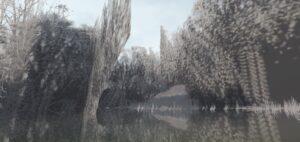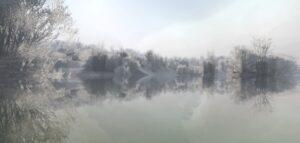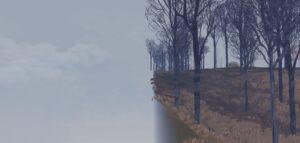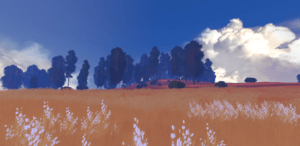For this week’s critical play I decided to step out of my comfort zone a bit and explore Places, as I hadn’t heard of it before and I was really curious as to how I would approach an experience that was not a game. Created by jlv and hosted online, Places features a number of interactive 3D worlds, self-described as “small and atmospheric 3D paintings”, where the player can walk through the world and experience it – there is no overarching gameplay or goal, the player simply takes in the atmosphere of the piece. These generally feature nature and scenery, no dialogue or other characters to interact with, and only the sounds of the environment around you and from your own movements. The scenes themselves range from wintery forests to beautiful summer plains.
Many of the Places had a clear mood and atmosphere that they were trying to communicate, and they did a wonderful job with immersing me in that feeling through a combination of visuals and diegetic audio. When you walk into water, you can hear the splashing sounds to the rhythm of your footsteps, and when you walk on grass you can hear a satisfying crunch of leaves and dirt beneath you. The way the space was physically divided, the way height and steepness could vary, and the way certain landmarks or beautiful views might be initially obscured also added a ton to the visual beauty of the scenery, and enough differentiation to make it worthwhile to walk through and explore each individual space.

(behind this shrubbery is…)

(this beautiful scene!)
I did quickly find though that there were a number of small things that detracted heavily from the immersion. First, the way that I traversed these landscapes often seemed contradictory towards the mood they were trying to portray. Each place gives you the option to both sprint and jump as opposed to just walking, and I feel like this heavily contrasts against the intention of these spaces to soak them in and enjoy their atmosphere. Sprinting and jumping let you reach pretty absurd speeds, where you could essentially fly by any landscape. It made it far more difficult to take things seriously – large foreboding hills or a wasteland didn’t feel as meaningful nor could I treat them with much reverence when I could basically whiz up them. While I could’ve simply chosen to not do that, the fact that the option was given to me made it feel like something that I should do and my curiosity got the better of me.
(you can go really really fast)
There were also a few technical issues, like the presence of clear world borders and edges, and repetitive sound effects, that really took me out of my immersion. While I understand this is the result of technical limitations, I think there are ways to mask the border of the world that would feel more natural and allow the space to feel real and lived in. Even an invisible wall at the end, but still having the landscape stretch onwards would have been helpful.

(the edge of the world)
Also, sound effects often didn’t align too well with the visuals that were presented. A gusting, almost droning breeze plays for almost every sketch and place, and it dominates the soundscape. And while it certainly suited some environments, like the post-apocalyptic field, adding to the emptiness, it heavily detracted from some of the environments, like this beautiful, more upbeat landscape here. The sound effect for moving through water also plays on essentially a fixed loop, which makes it less believable as diegetic sound, combined with the fact that the water never moves or reacts to you moving into it.

(I don’t know if foreboding wind is the best sound for this…)
Overall Places was an incredibly interesting experience with very high highs and very low lows, and I gained a number of key insights into what qualities help contribute towards making a digital environment immersive and which do not, and I’m hoping to use these insights for P2.



